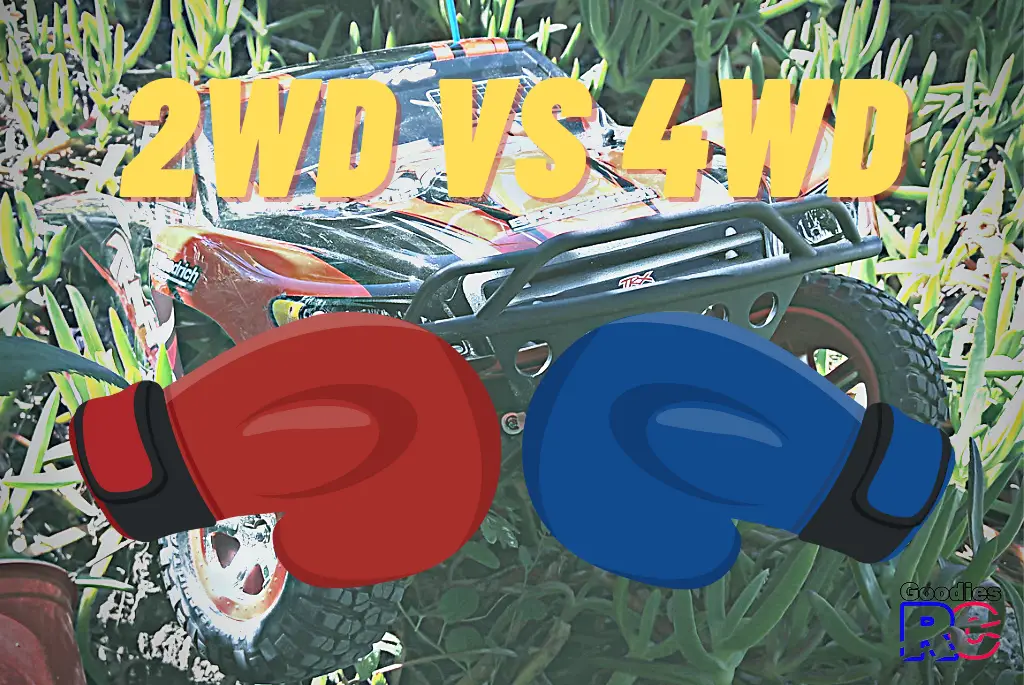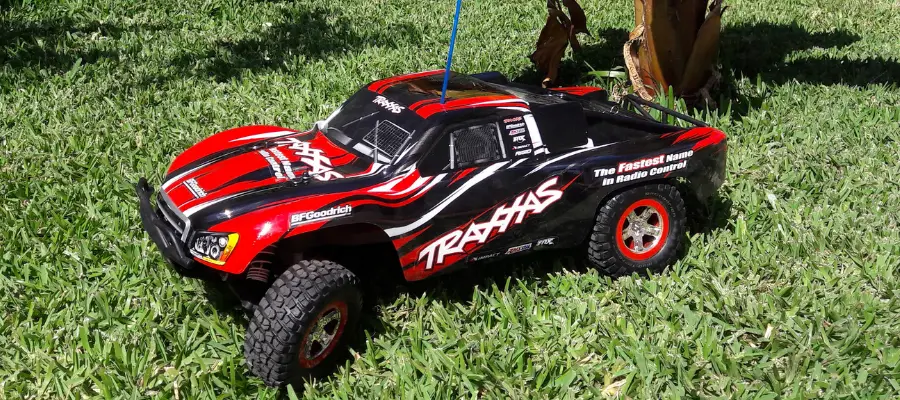If it’s your first time buying an RC car, it’s good to compare the differences between 2WD and 4WD. The choice might not be as obvious as you think, so I’ve listed all the key differences throughout this article to help you decide.
4WD RC cars are best for most people because they’re more powerful, don’t get stuck as easily, and handle well on most terrain. 2WD is better for drifting around corners, but they’re typically slower than 4WD, making them an excellent choice for beginners or children.
The overwhelming majority of hobby-grade RC cars are 4WD because they have more traction to push and pull them forward. They also brake quicker than 2WD RC cars.

But that only cracks the surface in terms of their differences. So here’s a more detailed list of pros and cons for each.
Pros of 2WD RC Cars
- They handle better while drifting if you spend some time learning how to handle it.
- It’s easier to perform donuts with a 2WD RC car.
- They’re typically cheaper than 4WD because they have fewer parts and don’t need big motors.
- With fewer parts at the front of the car, they’re cheaper to maintain and repair.
- 2WD RC cars are easier on the batteries so they last longer and don’t swell up as much.
- The front tires don’t wear out as quickly because they don’t spin on the ground and they also don’t pull the car forward like with 4WD.
- They are quicker and easier to clean because they have fewer parts.
- When landing on the front tires, there is no stress on the rest of the parts, like the transmission and motor, because they’re not connected to the front tires.
Cons of 2WD RC Cars
- They only generate traction on the back tires, which makes it more difficult to handle on rough terrain, sand, grass, or snow.
- Some types of tires will ruin the control of the vehicle.
- It’s much harder to drive up ramps and more difficult to control in the air. This is because the car’s weight isn’t balanced and because the rotation of only two tires causes the RC to rotate in the air.
- The braking system is weaker because it’s only applied to two wheels.
Pros of 4WD RC Cars
- Acceleration and top speeds are higher with 4WD because of the extra traction.
- The braking performance is better because it’s applied to all four wheels instead of two.
- 4WD doesn’t get stuck in the sand as easily.
- It’s easier to recover from crashes and rolling.
- Handles rough off-road terrain like sand, gravel, grass, and dirt better than 2WD.
- Excellent traction and handling with almost any type of tire.
- 4WD is much easier to drive up ramps and land on its wheels.
Cons of 4WD RC Cars
- They draw a lot of power from the batteries, which makes them run down quicker and sometimes even puff up.
- They need stronger motors and more parts, which makes them more expensive to buy and maintain.
- All four tires wear down quickly because they all create traction with the ground.
- Takes more time to clean because of the extra internal parts.
- Landing on the front wheels after a jump causes a sudden shock to the transmission and motor, which will lead to replacing of broken parts.
Drifting With A 4WD RC Car
You can drift with a powerful 4WD RC car if you practice enough on the right type of terrain. Dirt tracks are where you’ll be able to drift. You’ll need to hit the acceleration hard so that the tires lose traction and “drift” along the track. It works the same as full-sized rally cars.
The rear end of 4WD cars don’t swing out like 2WD, so all four tires spin and make the car slide differently to a 2WD, but you’ll be able to drift with either one.
With 2WD cars, the back of the car slides out more than the front because when the back tires spin, they lose grip/traction and therefore makes it easier to get tighter drifts, but it’s not impossible with 4WD, as long as the motor is strong enough.
See my related article: 9 Ways To Make An RC Car Drift Better
Also see my article: How fast do RC Drift cars go?
Is 4WD Better Than 2WD For RC Racing
4WD RC cars are better for racing because they have more traction, especially on dirt. 4WD cars don’t get stuck in sand or foliage as easily as 2WD cars. 4WD RC cars accelerate faster and have higher top speeds because the power is distributed through all four tires at once.
However, 2WD RC cars are extremely fun for racing because the lower speeds are easier to control. This is also why beginner RC racers start off with 2WD and then progress to 4WD once they get the hang of things. It’s also easier to drift around corners if the motor is powerful enough to spin the wheels fast enough.
4WD VS AWD: Is There A Difference?
With 4WD RC cars, the motor delivers power to all four wheels equally at all times. With AWD RC cars, electronics like Traxxas Stability Management distributes varying amounts of power to all four wheels and gets the optimum traction for any situation. This helps the car get out of sticky situations and greatly increases handling.
The vast majority of RC cars are 4WD and not AWD because this type of technology is on the top tier of hobby-grade RC cars. So it’s not really affordable for everyone. Here’s more information about AWD VXL chassis on the Traxxas website: VXL AWD Chassis.
Traxxas Slash 2WD VS 4X4

The two back wheels are powered by the motor with standard Traxxas Slash, but the Slash 4X4 powers all four wheels with the same motor, so which one is best for you?
The 2WD Slash has the motor positioned on the rear of the car, which will make it difficult to control in the air. The 4X4 has the motor slightly closer to the center of the chassis, making it more balanced and easier to control in the air.
The 4WD has a center drive shaft running through the middle of the car to power the front wheels. Of course, it also has a second differential in the front and another set of drive shafts to power the front tires. All this is great for the performance increase, but will cost you more to buy and maintain.
The combination of the back and front tires pushing and pulling together creates a massive amount of forward momentum. This means that the acceleration is improved immensely. Unlike full-size cars, 4WD RC cars actually do brake harder than 2WD because the motor is what generates the braking power. So the braking is applied to all four wheels, making it easier and faster to stop.
In the end, the 4X4 will perform better in terms of acceleration, top speed, handling and longevity. But they’re more expensive to buy and maintain than 2WD RC cars.
The 4X4 is more expensive because of the extra parts to make it 4X4, but if you’re anything like me, it’s well with the investment.
Here are the latest offers for both options on Amazon: Traxxas Slash / Traxxas Slash 4X4 brushless
Conclusion
I prefer 4WD RC cars over 2WD because of all the extra performance I get out of it. Of course, if it’s just for drifting around tracks, I might go for a 2WD option. 2WD is a good choice for a first time RC driver or children because they don’t accelerate up to uncontrollable speeds as quickly as 4WD. Also, an inexperienced driver can easily damage a 4WD car if they land on the front wheels after jumps, so a 2WD RC car can be a cheaper option just to learn how to control it properly before going 4WD.
If you’re not planning on driving off-road with your car, the 2WD could be the choice for you because you won’t need extra traction when driving on pavement and other grippy surfaces.
